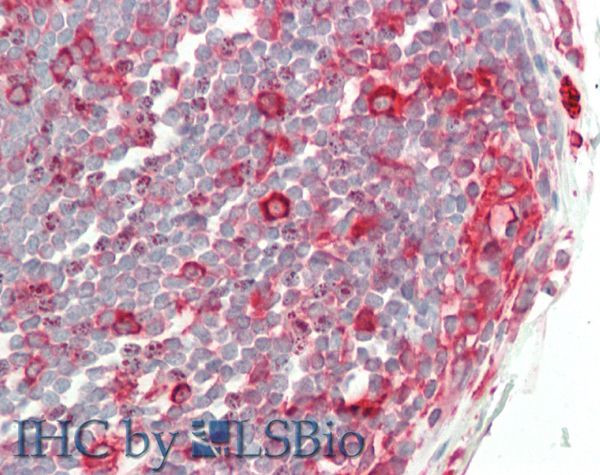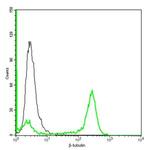Search Thermo Fisher Scientific
产品信息
A01717-40
种属反应
已发表种属
宿主/亚型
分类
类型
克隆号
抗原
偶联物
形式
纯化类型
保存液
内含物
保存条件
运输条件
产品详细信息
Reconstitute the lyophilized powder with deionized water (or equivalent) to an antibody concentration of 0.5 mg/ml.
Tubulin is the major constituent of microtubules. It binds two moles of GTP, one at an exchangeable site on the beta chain and one at a non-exchangeable site on the alpha-chain. It is a dimer of alpha (a) and beta (ß) chains. ß-tubulin is ubiquitously expressed with highest levels in spleen, thymus and immature brain and it has a highly acidic C-terminal region which may bind cations such as calcium. This antibody can be used as a loading control on Western blots.GenScript ß-tubulin Antibody (2G7D4), mAb, Mouse is produced from the hybridoma resulting from fusion of SP2/0-Ag14 myeloma and B-lymphocytes obtained from mouse immunized with purified human recombinant full-length ß-tubulin protein.
靶标信息
Beta tubulins are one of two core protein families (alpha and beta tubulins) that heterodimerize and assemble to form microtubules. Beta-III tubulin is primarily expressed in neurons and may be involved in neurogenesis, axon guidance and maintenance. Mutations in the beta tubulin gene are the cause of congenital fibrosis of the extraocular muscles type 3. Beta-III tubulin was also detected in Sertoli cells of the testis and transiently in non-neuronal embryonic tissues. Glutamate residues at the C-terminus of beta III tubulin can be glutamylated. The precise function of such modifications is unclear. Tubulin is phosphorylated on Ser-172 by CDK1 during cell cycle progression. Ser-172 phosphorylation inhibits tubulin incorporation into microtubules.Microtubules, the major cytoskeletal elements found in all eukaryotic cells, consist of Tubulin, which is a dimer of two 55 kDa subunits: alpha and Beta. Microtubules play key roles in chromosome segregation in mitosis, intracellular transport, ciliary and flagellar bending, and structural support of the cytoskeleton. Because beta-tubulin is ubiquitously expressed in all eukaryotic cells, it is frequently used as a loading control for assays involving protein detection, such as Western blotting.
仅用于科研。不用于诊断过程。未经明确授权不得转售。
生物信息学
蛋白别名: beta 5-tubulin; beta Ib tubulin; beta tubulin 1; beta-4 tubulin; beta-4-tubulin; beta-5 tubulin; beta-tubulin; Beta-tubulin class-I; Beta-tubulin class-II; beta-tubulin class-III; Beta-tubulin class-V; Beta-tubulin class-VI; beta-tubulin T beta15 (aa 1-445); betaIII-tubulin; c(beta)7 tubulin; class II beta-tubulin isotype; class IIa beta-tubulin; class IIb beta-tubulin; class III beta-tubulin; class V beta-tubulin; dJ40E16.7; dystonia 4, torsion (autosomal dominant); HSA10p15 beta-tubulin 4Q; M40 antibody; Neuron-specific class III beta-tubulin; T beta-15; TUBB; tubb2a {ECO:0000250|UniProtKB:Q7TMM9}; Tubulin 5 beta; tubulin beta; Tubulin beta 4'; Tubulin beta 8 class VIII; Tubulin beta chain; Tubulin beta class IIa; Tubulin beta class V; tubulin beta MGC4083; Tubulin beta-1 chain; Tubulin beta-2 chain; Tubulin beta-2A chain; Tubulin beta-2B chain; Tubulin beta-3 chain; Tubulin beta-4 chain; Tubulin beta-4A chain; Tubulin beta-5 chain; Tubulin beta-6 chain; Tubulin beta-7 chain; Tubulin beta-8 chain; Tubulin beta-III; tubulin, beta 1 class VI; tubulin, beta 2; tubulin, beta 2A; tubulin, beta 2A class IIa; tubulin, beta 2B class IIb; tubulin, beta 3; tubulin, beta 3 class III; tubulin, beta 4; tubulin, beta 4 class IVa; tubulin, beta 4A class IVa; tubulin, beta 6 class V; tubulin, beta class I; tubulin, beta family 1; tubulin, beta polypeptide; tubulin, beta polypeptide 2; tubulin, beta polypeptide paralog; tubulin, beta, 3; tubulin, beta, 4; tubulin, beta, 5; unnamed protein product
基因别名: 2310057H16Rik; 2410129E14Rik; 2810484G07Rik; 3200002H15Rik; AA408537; AI325297; AI596182; B130022C14Rik; bA506K6.1; bA631M21.2; BB220206; beta-4; beta-5; brdp; CDCBM; CDCBM1; CDCBM5; CDCBM6; CFEOM3; CFEOM3A; CSCSC1; DYT4; FEOM3; HsT1601; M(beta)1; M(beta)2; M(beta)3; M(beta)4; M(beta)5; M(beta)6; M40; OK/SW-cl.56; OOMD; OOMD2; PMGYSA; RGD1305887; RGD1309427; TUBB; TUBB-5; TUBB1; TUBB2; TUBB2A; TUBB2B; TUBB3; TUBB4; TUBB4A; TUBB5; TUBB6; TUBB8
UniProt ID: (Chicken) P09244, (Human) P07437, (Pig) Q767L7, (Bovine) Q2KJD0, (Chicken) P09207, (Human) Q9H4B7, (Human) Q13885, (Human) Q9BVA1, (Chicken) P32882, (Bovine) Q6B856, (Bovine) Q2T9S0, (Human) Q13509, (Bovine) Q3ZBU7, (Human) P04350, (Human) Q9BUF5, (Chicken) P09653, (Bovine) Q2HJ81, (Human) Q3ZCM7, (Mouse) A2AQ07, (Rat) P85108, (Mouse) Q7TMM9, (Mouse) Q9CWF2, (Rat) Q3KRE8, (Mouse) Q9ERD7, (Rat) Q4QRB4, (Mouse) Q9D6F9, (Mouse) P99024, (Rat) P69897, (Mouse) Q922F4
Entrez Gene ID: (Rabbit) 100349792, (Goat) 102168953, (Chicken) 396254, (Human) 203068, (Pig) 733686, (Rabbit) 100358689, (Bovine) 615087, (Chicken) 396427, (Pig) 100134983, (Bovine) 541271, (Goat) 102188330, (Human) 81027, (Rabbit) 100347858, (Chicken) 768337, (Goat) 108633269, (Human) 7280, (Human) 347733, (Chicken) 420883, (Bovine) 281555, (Pig) 100153507, (Bovine) 768070, (Human) 10381, (Chicken) 431043, (Bovine) 540236, (Human) 10382, (Goat) 102178062, (Pig) 100736584, (Rabbit) 100348290, (Pig) 100623583, (Rabbit) 100350252, (Goat) 102178409, (Human) 84617, (Chicken) 421037, (Bovine) 534206, (Human) 347688, (Mouse) 545486, (Rat) 679312, (Rat) 498736, (Mouse) 22151, (Mouse) 73710, (Rat) 291081, (Mouse) 22152, (Rat) 246118, (Rat) 29213, (Mouse) 22153, (Mouse) 22154, (Rat) 29214, (Mouse) 67951, (Rat) 307351






